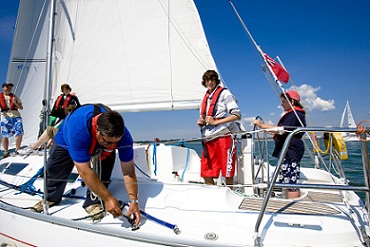When it comes to learning to sail it would be easy to assume that someone would start off small, and slowly work their way up to a larger vessel.
While this can make sense in that an amateur shouldn’t be left with something they cannot handle, finding the best boat to learn in can depend on a number of factors.
The performance of a boat will vary greatly, so finding one that meets the needs of any individual sailor will be key to ensuring they enjoy their sailing experience.
When learning the basics, a sailor will want a vessel in which they feel comfortable – not only will this improve confidence but it will boost the speed at which they learn as well.
All-purpose boats are great for learning in, as they have the capabilities of supporting all the necessary equipment and procedures that are required.
Other types of newer vessel tend to be specially designed for racing and speed, making them far less suitable for learning purposes.
When it comes to picking a vessel in which to learn to sail there are three main things to consider: size, design and capacity.

Size is of vital importance as something too big can be too difficult to handle, while a vessel that is too small can be simply not big enough for a sailor and an instructor.
Typically, a vessel between 11 feet (3.3m) and 16 feet (4.8m) is thought to be the ideal size for these very reasons.
The type of sailing will also have an impact on this decision, as some rowing boats are typically longer due to their nature of use.
An average 14-foot boat is capable of carrying two or three people comfortably so while the difference in size might seem trivial, it can make all the difference.
When learning to sail, that extra bit of space can really come in handy – a sailor must have confidence in their boat and this is difficult to achieve if it is not big enough for purpose.
Capacity and size are very closely linked when it comes to boats – larger boats will tend to have more space but that is not always the case.
One decision that needs to be made when considering a vessel in which to learn will depend on how many people will be in the boat at any one time.
This will also impact upon the levels of equipment that can be carried, with certain safety measures required at all times.
As with any type of vehicle such as a car or a motorbike, boats are also made from a great variety of materials.
While one boat could be made from wood, another could be made from fibreglass and there is no set rule for what makes a good or a bad boat.
It’s very important to remember here that no single feature on a boat will be critical – only the boat as a whole is what matters when it comes to design.
Ideally, sailors will look for a boat that is large enough to carry the necessary people that it needs to, while it should also be stable.
Sitting in the boat when at the dock is a good way to test this, as it should be possible to sit near to the side of the vessel without it tipping in an alarming fashion.
A boat for someone learning to sail should also be relatively simple in terms of the rigging and number of sails – one is more than adequate at this stage of your development.
Encouraging people to get involved in sailing is dependent on them learning in comfortable conditions, and that is reliant upon having a boat that is fit for purpose.
While bigger is not always necessarily better, choosing a slightly larger vessel could have a tremendous impact on a sailor’s experience, especially when they are a beginner.